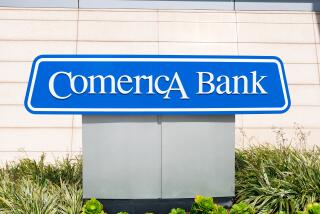Bills Would Bail Them Out Too : Many Rural Banks Also in Danger of Financial Ruin
- Share via
WASHINGTON — It is not only the nation’s farmers who are facing a financial crisis this winter. So are their bankers. And the link is intensifying the political and economic drama unfolding in Congress.
An enormous number of farmers are mired in debt, desperately in need of refinancing to stay in business. At the same time, an alarming number of rural banks have failed, and many more are in danger of collapse.
Each depends on the other--the farmers need bank loans, and the banks need repayments from farmers--and trouble for one spells trouble for the other.
Thus, the controversial bills that passed the House and the Senate on Wednesday would bail out farmers principally by bailing out banks. And, despite simultaneous efforts to slash $200-billion federal deficits, the government would have to pay for most of the relief. Cost estimates range from $100 million all the way up to $9 billion, depending on how many farmers would receive help and how many could repay their federally backed loans.
Amid the cornucopia of grain in the nation’s Farm Belt is a staggering amount of pain:
--Fully 420,000 of America’s 2.4 million farmers are considered “financially stressed,” with debts totaling at least 40% of their assets.
--Five rural banks have failed so far this year, following 26 in 1984. Twenty-two of the 1984 failures occurred in the last half of the year. With failures accelerating, 275 rural banks have been placed on the “problem loan” list of the Federal Deposit Insurance Corp.
Federal and state officials constantly question how many debt-burdened farmers can, or should, be kept in business. And, if they go under, what will be the cost to rural banks, whose funds are the lifeblood of the agricultural community?
Most farm experts agree that there is little hope for about 160,000 farmers whose debt is so enormous--exceeding 70% of their assets--that neither commercial banks nor governmental agencies are willing to help them any longer. “They are just too far gone,” said Weldon Barton, agricultural lobbyist for the Independent Bankers Assn. of America.
It is the remaining 260,000 farmers in the “financially stressed” category who are the targets of most of the emergency relief proposals.
Immediate Loan Advances
The bills passed Wednesday would allow needy farmers to obtain immediate advances on federal crop loans, which they normally would receive at harvest time. Rep. Thomas A. Daschle (D-S.D.), the author of the proposal, contends that 200,000 farmers could benefit. But Eugene Moos, a top staff member of the House Agriculture Committee, is strongly skeptical, citing the “nightmare” paper work task of processing 200,000 loans before spring planting.
Agriculture Secretary John R. Block charges that the Daschle proposal would subvert the harvest loan program and lead to increased loan defaults costing taxpayers up to $9 billion.
The bill passed by the House would also provide $3 billion in federal loan guarantees to protect banks against defaulted farm loans, on top of the current $650-million loan guarantee program. The Senate bill would provide $1.85 billion in additional loan guarantees.
Fewer Than 100 Loans
To qualify for loan guarantees, banks must reduce their interest rates enough so that farmers can project that they will break even on their operations. Under the current program, banks have given loans to fewer than 100 distressed farmers, despite two rounds of adjustments this month aimed at enhancing the program’s appeal to banks.
The banks say they have not participated because, to guarantee that farmers break even, they must slash interest rates below the point of profitability to themselves.
But Block charges that the banks are simply holding out for “sweeter” risk protection from Congress. “They’re hoping for a bank bail-out bill,” said John D. Ochs, Block’s press secretary.
$100 Million in Subsidies
The Senate bill, which was sponsored by Democrats with some Republican backing, also would provide $100 million in interest subsidies to help banks make emergency loans to an estimated 35,000 farmers in need of refinancing. The $100 million would be intended to “buy down” the interest rates offered to farmers by about four percentage points; Block calls it a budget buster.
Ochs predicted that banks would help a “sizable” number of farmers, even without bail-out legislation. But Barton of the Independent Bankers Assn. said it is difficult to say how much banks will do.
“Banks can’t be expected to take the full hit,” Barton said. “Banks are going to move interest rates down as much they can to stay with the (farmers) because it is in everybody’s interest to do so.”
More to Read
Sign up for Essential California
The most important California stories and recommendations in your inbox every morning.
You may occasionally receive promotional content from the Los Angeles Times.













